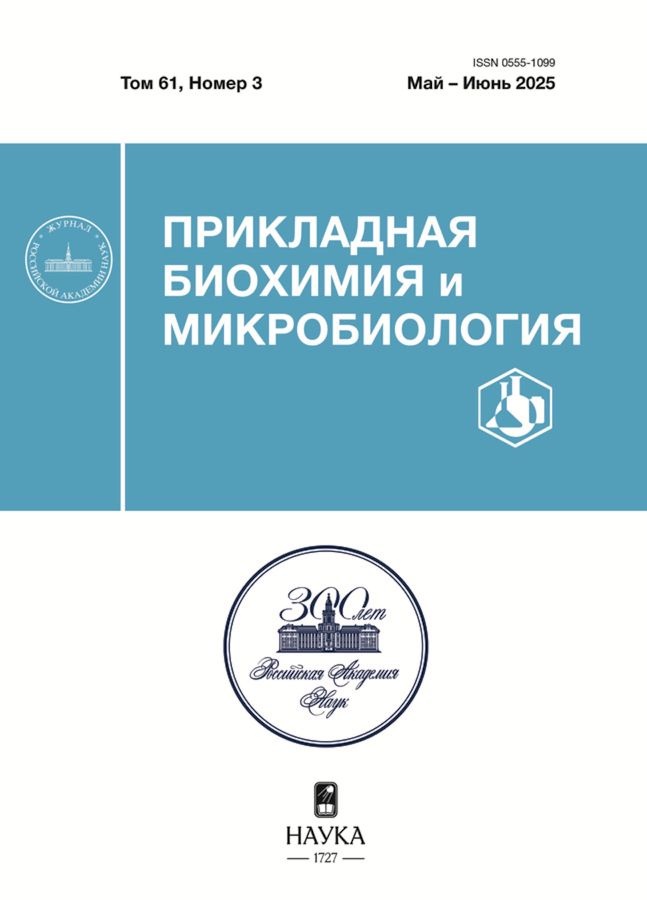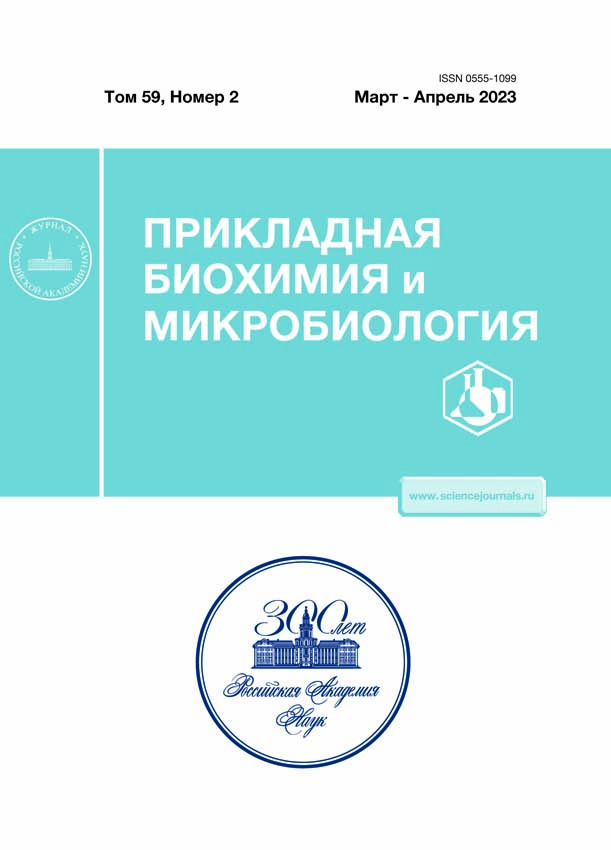Том 59, № 2 (2023)
Статьи
Внеклеточные везикулы бактерий – медиаторы межклеточной коммуникации: практические приложения и инновационные технологии (обзор)
Аннотация
Внеклеточные везикулы (ВВ), секретируемые клетками бактерий, в фокусе внимания исследователей. Они обогащены биоактивными молекулами, опосредуют межклеточную коммуникацию микро- и макроорганизмов, участвуют в адаптации бактерий к стрессовым условиям, репрограммировании клеток-мишеней, модуляции иммунореактивности у высших организмов, изменении структуры микробных сообществ и экосистем. Уникальные свойства бактериальных внеклеточных везикул (БВВ) открывают широкие перспективы их практического применения – в клинической медицине, сельском хозяйстве, биотехнологии и экологии в качестве диагностических маркеров, вакцин, новых биопрепаратов и средств их доставки. Однако для реализации практических приложений необходимо решить ряд проблем. Настоящий обзор сосредоточен на проблеме неоднозначной роли БВВ в регуляции живых систем, безопасности БВВ и подходам к ее решению, связанным с инновационными технологиями.
 107-119
107-119


Пробиотические свойства сахаромицетов (обзор)
Аннотация
Цель обзора – обобщение и анализ информации о молекулярно-генетических основах и методах исследования пробиотической активности грибов класса Saccharomycetes, механизмах их физиологического действия и применении в биотехнологии. В настоящее время эффективность Saccharomyces boulardii при лечении и для профилактики диарей различной этиологии, рецидивов инфекции Clostridium difficile, побочных эффектов терапии инфекции Helicobacter pylori установлена с высоким уровнем доказательности. Генетические, цитологические, культуральные и биохимические особенности S. boulardii определяют их пробиотическую активность. Другие штаммы сахаромицетов с пробиотическим потенциалом чаще всего выделяют из национальных ферментированных продуктов из растительного и молочного сырья. Единая методика исследования пробиотических свойств пока не создана, для их подтверждения необходимы клинические испытания с участием людей. Перспективными пробиотиками являются штаммы видов Saccharomyces cerevisiae и Kluyveromyces marxianus, имеющих международный статус безопасности. Возможные механизмы физиологического действия сахаромицетов включают антимикробные, антитоксические, трофические, антисекреторные и противовоспалительные эффекты. Некоторые механизмы пробиотического действия дрожжей отличаются от бактериальных и не все они пока понятны. Сахаромицеты-пробиотики могут быть использованы для повышения биологической ценности, качества и безопасности пищевых продуктов.
 120-132
120-132


Использование сульфатредуцирующих бактерий в биоремедиации от тяжелых металлов и металлоидов (обзор)
Аннотация
Загрязнение окружающей среды тяжелыми металлами, металлоидами и радионуклидами представляет собой проблему мирового значения, в значительной степени влияющую на состояние биосферы. В частности, соединения хрома обладают токсичным, мутагенным и канцерогенным действием. Основной принцип очистки антропогенных и природных экосистем от хроматов – восстановление Cr(VI) до Cr(III), соли которого существенно менее токсичные и нерастворимые. Однако используемые в настоящее время электрохимические и ионообменные методы очистки достаточно дороги и требуют применения специальных реагентов. В то же время, особый интерес для биоремедиации представляют сульфатредуцирующие бактерии (СРБ), поскольку многие из них весьма устойчивы к высоким концентрациям тяжелых металлов и способны эффективно восстанавливать их в присутствии водорода как донора электронов. В обзоре суммированы сведения о взаимодействии тяжелых металлов, металлоидов и радионуклидов с клетками СРБ. Рассматриваются особенности метаболизма этих микроорганизмов, приводящие к внутриклеточной аккумуляции тяжелых металлов и металлоидов, сложные и тонко регулируемые ферментативные механизмы восстановления токсичных металлов (с использованием различных цитохромов, гидрогеназ, оксидоредуктаз, узкоспецифичных металлредуктаз и тиоредоксин/тиоредоксинредуктазных систем), а также возможность применения иммобилизованных клеток и биопленок СРБ в эффективной биоремедиации природных вод, почв и промышленных стоков.
 133-149
133-149


Использование фаговых антител для определения микробных клеток (обзор)
Аннотация
Технология фагового дисплея антител произвела революцию в области иммунодетекции бактерий. Данная технология позволяет экспрессировать антитело, слитое с белком оболочки нитевидного бактериофага. Применение фагового дисплея позволяет получать высокоаффинные антитела, минуя этап иммунизации животных, сокращая время получения стабильных клонов, продуцирующих антитела, с нескольких месяцев до нескольких недель, заметно удешевляя процесс. Данные преимущества делают фаговые антитела важным инструментом для детекции бактерий. В работе представлено краткое описание технологических приемов при получении фаговых антител к микробным клеткам. Обсуждаются возможности и перспективы применения фаговых антител в качестве селективного агента в аналитических системах, в том числе в биосенсорах.
 150-166
150-166


Получение растворимого интерферона гамма человека в системе экспрессии Escherichia coli при снижении температуры культивирования
Аннотация
Сконструирован рекомбинантный штамм–продуцент интерферона гамма человека (ИФН-γ) E. coli BL 21/pЕТ-IFN-γ, обеспечивающий высокий уровень его экспрессии. Разработан способ получения растворимой формы рекомбинантного ИФН-γ, включающий наработку биомассы штамма-продуцента, содержащего целевой белок в количестве 32–37% от общего содержания клеточных белков, из которых 15–17% в растворимой форме, выделение и очистку белка. Процесс выделения и очистки включал стадии дезинтеграции, осветление лизата клеток, хроматографической очистки и диализа. Разработанный способ позволил получить из 1 г влажной биомассы до 5 мг препарата с чистотой не менее 95% и высокой специфической (противовирусной) активностью.
 167-173
167-173


Образование различных изоформ антимикробных пептидов эмерициллипсинов у Emericellopsis alkalina при разных условиях культивирования
Аннотация
Проведена оценка способности образования противогрибкового антибиотика эмерициллипсина А у штамма гриба Emericellopsis alkalina E101 в различных биотехнологических системах при нейтральных и щелочных рН. Установлено, что новый апробированный мембранно-жидкостной способ культивирования при рН 10 увеличивал выход основного компонента эмерициллипсина А в 1.7 раза. Показано, что новый способ культивирования штамма E. alkalina E101 также способствовал синтезу различных изоформ основного компонента эмерициллипсина А.
 174-181
174-181


Синергетическое взаимодействие арабиназ разного типа действия при биоконверсии свекловичного жома и яблочных выжимок
Аннотация
Изучено взаимодействие эндоарабиназы (эндоА) с ферментами экзо-типа действия при совместном гидролизе разветвленного арабинана (РАра), свекловичного жома (СЖ) и яблочных выжимок (ЯВ). Показано, что при гидролизе РАра наиболее эффективными были смеси эндоА с арабинофуранозидазой (АФ) или арабиноксилан-арабинофурангидролазой (АКГ) с содержанием эндоА 20 и 40% соответственно. В результате оптимизации комплекса арабиназ, целлюлаз и пектиназы осуществлен практически полный гидролиз ЯВ в моносахариды (арабинозу, глюкозу, фруктозу). При гидролизе СЖ степень конверсии гемицеллюлозы (арабинана) составила более 50%, целлюлозы – 75%.
 182-190
182-190


Обесцвечивание красителей в биоэлектрохимической системе при иммобилизации клеток Shewanella oneidensis MR-1 на поверхности анода и электрической стимуляции внешней цепи
Аннотация
Обнаружено влияние полярности электрической стимуляции внешней цепи биоэлектрохимической системы, а также иммобилизации на аноде клеток Shewanella oneidensis MR-1, содержащих ген пероксидаз класса DyP, на скорость обесцвечивания красителей разных типов. Для красителя трифенилметанового кристаллического фиолетового максимальная скорость обесцвечивания суспендированными клетками S. oneidensis MR-1 составила 2.05 ± 0.07 мкМ/ч и наблюдалась при подключении источника постоянного напряжения 1.2 В прямой полярности. Минимальные скорости наблюдались в случае обратной полярности подключения. При иммобилизации клеток на аноде удельная скорость обесцвечивания была выше, достигая 2.91 ± 0.09 мкМ/ч и не снижалась при повышении концентрации субстрата. Наименьшие показатели также были отмечены для обратного подключения источника напряжения. При обесцвечивании азокрасителя конго красного, максимальные значения скорости отмечены для источника с прямым подключением ионистора и при разомкнутой цепи (0.26 ± 0.01 и 0.29 ± ± 0.02 мкМ/ч соответственно), минимальное значение 0.11 ± 0.02 мкМ/ч наблюдали для обратного подключения. Для продуктов биоэлектрокаталитического обесцвечивания кристаллического фиолетового обнаружено значительное снижение интенсивности главного пика поглощения, соответствующего полосе 590 нм, практически без гипсохромного сдвига. О качественных изменениях состава продуктов обесцвечивания говорит появление нового максимума поглощения в районе 360 нм для варианта с прямой полярностью подключения ионистора. Результаты могут представлять интерес для разработки новых методов биоэлектрохимической очистки.
 191-199
191-199


Влияние бактериальных мутуалиста и фитопатогена на изменение концентраций цАМФ и Н2О2 в проростках гороха сорта рондо и его бесклубенькового и суперклубенькового мутантов
Аннотация
Исследованы изменения концентраций пероксида водорода и циклического аденозинмонофосфата (цАМФ) в корнях проростков гороха сорта Рондо и его суперклубенькового мутанта Nod3 и бесклубенькового К14 при инфицировании Rhizobium leguminosarum bv. vicieae (штамм RCAM 1022) или Pseudomonas syringae pv. pisi (штамм 1845). Показано, что через 360 мин после инфицирования проростков гороха сорта Рондо уровень эндогенного пероксида водорода незначительно отличался от контроля. В корнях проростков Nod3 этот уровень существенно снижался, а в корнях К14 достоверно возрастал при инфицировании штаммом 1845, но оставался без изменений при воздействии бактерий штамма RCAM 1022. В тоже время инфицирование RCAM 1022 в течение 360 мин приводило к резкому возрастанию уровня цАМФ в зонах зачатков и молодых волосков корня проростков Рондо, тогда как штамм 1845 не оказывал влияния на этот показатель. На концентрацию цАМФ в корнях проростков мутанта Nod3 оба вида бактерий не оказывали воздействия, тогда как у К14 под воздействием RCAM 1022 уровень цАМФ возрастал почти в 2 раза, а под воздействием 1845 – снижался. Предполагается, что пероксид водорода и цАМФ могут принимать участие в формировании суперклубенькового и бесклубенькового фенотипов мутантов, а также в формировании устойчивости к специфическому патогену, Pseudomonas syringae pv. pisi. Возможно, что данный феномен можно использовать для диагностики устойчивости вновь создаваемых мутантов и сортов гороха к возбудителю бактериального ожога.
 200-207
200-207


Биопрепарат на основе иммобилизованных микроорганизмов как основа высокоэффективных органических удобрений нового поколения
Аннотация
На основе бактерий Bacillus megaterium и Azotobacter сhroococcum, иммобилизованных в гидрогель модифицированного поливинилового спирта создано 2 биопрепарата. Показано, что при применении разработанных биопрепаратов происходит увеличение влажности почвы (в 2 раза), всхожести (до 100%), длины стебля и корня кресс-салата (на 15–30%). При применении биопрепарата на основе Azotobacter chroocоcсum происходило обогащение почвы азотом (в 2 раза). Жизнеспособность бактерий в гидрогеле на основе поливинилового спирта, модифицированного янтарной кислотой составляла более 30 сут, что позволило создать эффективные биоудобрения нового поколения на их основе.
 208-216
208-216













